Ampel and cascade petunias: features and differences
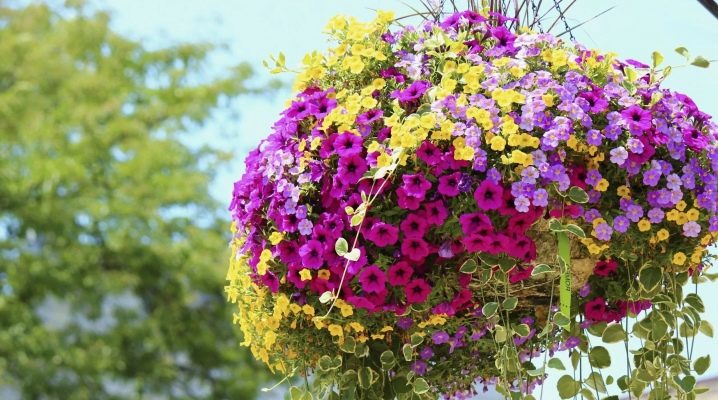
For a beautiful and effective flower garden design, it is important to be able to choose the right flowers. In addition to the variety of shapes and colors, you need to pay attention to their durability, care conditions and whimsicality. Among the most beautiful and easy to care for flowers, it is worth highlighting petunias, having two main varieties: ampelous and cascading, which will be discussed below.
Description
Petunia belongs to flowers from the Solanaceae family, and it got its name from the Latin word petun - tobacco, due to the great similarity with this plant in the structure of the corolla, as well as in its habitat: South America and Brazil. Now you can find at least forty species of petunias, which are significantly different from those found in tropical forests.
Breeders have been actively working on the creation of new varieties of flowers since the 18th century and have achieved good results. Petunias growing in their native territory are perennials; in other climatic conditions, more severe than usual for them, they grow no more than one season. Depending on the variety, the appearance of the plant can vary significantly: for example, the stem is creeping, creeping and erect, having different lengths.
Petunia grows quickly and closes the area around it as much as possible. Twigs and foliage are poorly pubescent, which is why many pests prefer to bypass this flower.
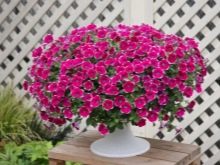
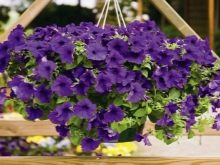
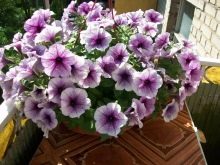
The structure of the corolla has five petals that grow together to the base and form a long tube in which the stamens are located. The color variety of the corolla is enormous - thanks to the work of breeders, there are both monochromatic and two-color varieties.
Thanks to a wide palette of colors, it is possible to create a gorgeous flower bed that will delight with flowering for a long time. After the corolla wilts, a seed capsule forms in its place, thanks to which the flower sows itself for the next season.
If petunia is bred by breeders, then self-seeding will not give the same new flower: it will lose its distinctive features and a simple plant variety will grow.


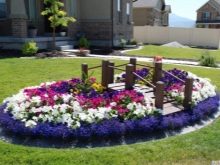
If we talk about the types of growth of petunias, then there are three varieties in total:
- bush;
- ampelous;
- cascading.
Most often, you can see exactly the bush version, which is easy to grow and cultivate. This petunia has an erect stem, it grows well and blooms profusely. There are dwarf varieties, multiflora and grandiflora.
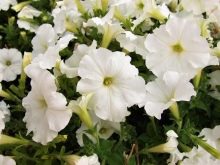
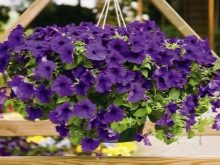
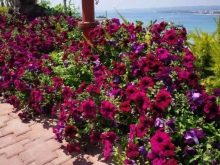
Dwarf option usually grows at home due to the low height of the bush, which is about 20 cm. The stem is strong and branched, the flowers are small, shaped like a gramophone, blooms profusely. The advantages of this variety can be considered the ability to easily tolerate any temperature extremes and resistance to fungal diseases.
Multiflora is similar in structure to the dwarf version due to strong and erect stems, but their height can reach 40 cm. The flowering is very abundant, it is not always possible to see the foliage of the plant behind the color. The corolla has an average size - from 5 to 7 cm - hybrid varieties can reach 15 cm.The disadvantages of this option include poor resistance to a humid habitat: after prolonged rainfall, the corollas become less attractive, and the plant itself can be infected with a fungal disease.
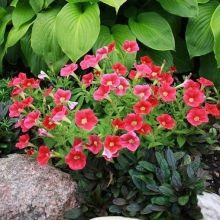
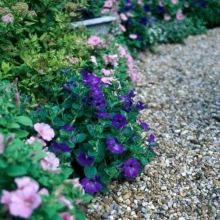
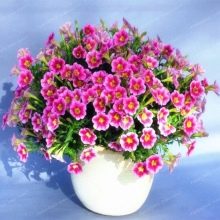
Grandiflora differs from all other petunias with flowers of the largest size, reaching 15 cm in diameter. The choice of each of the options is dictated by the goals for which the flowers are selected. In addition to the aforementioned varieties, it is worth talking separately about the ampelous and cascading varieties of petunias.
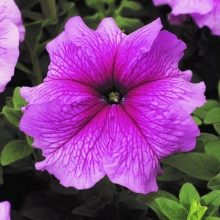
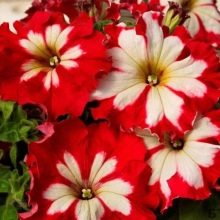
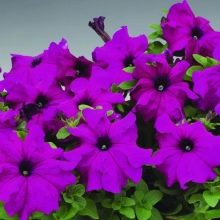
Ampelnaya
The ampel option is often used to decorate suspended structures, pots and stands on a leg. Flower stems can grow from 30 cm to a meter, they do not rise up, but spread or hang from a hill. The word "ampelous" itself comes from the German ampel - a hanging vase. Young foliage is small, older leaves grow considerably and form a green “cap” at the base of the flower. The flowers grow from the axils of the leaves along the entire length of the stem; the corolla has an average size of 3 to 10 cm.

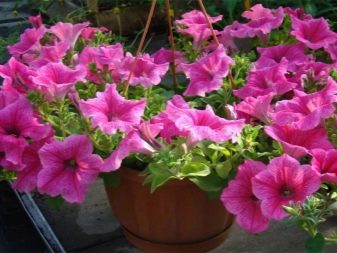
Breeders have developed varieties with all possible colors of the spectrum, because there is an opportunity to create a unique composition of these amazing flowers. Ampel petunia is distinguished by a two-tone flower color or a change in shade to a more saturated one near the funnel. The most popular are the surfinii petunias, which were bred by the Japanese breeders of the Suntory firm.
These plants tolerate the vagaries of nature well and delight the eye with a variety of colors. Such a flower can only be propagated vegetatively.

Among the best varieties, the following are worth noting.
- Surfinia - has flowers of various shades. Propagation is possible only thanks to cuttings. The flower has a large number of stems that are actively branching. The advantage is resistance to weather disasters.
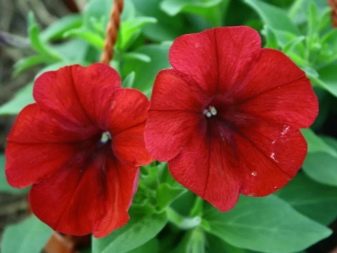
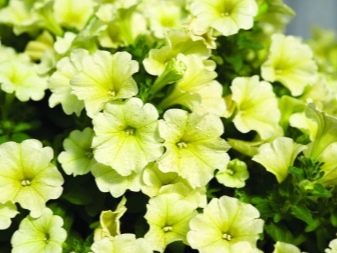
- "The Snow Queen" - differs in shoots of short length. The flowers are white in color and have a pleasant aroma.
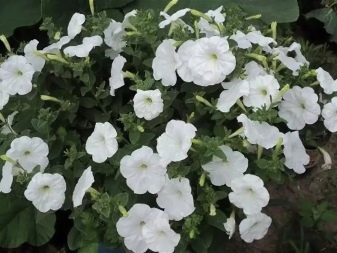
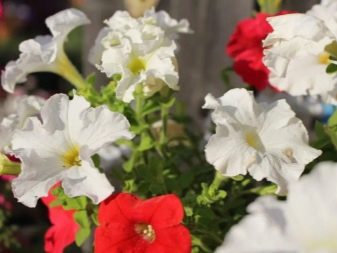
- "Velveteen" - differs in the velvety structure of both the leaves and the flowers themselves. It is one of the best honey plants.
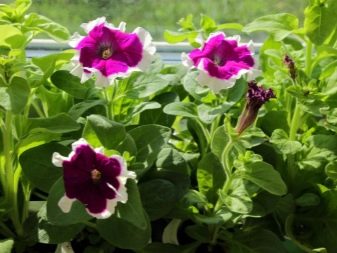
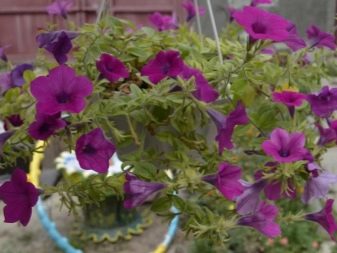
- "Avalanche" - there are pink, white and purple color varieties. The main advantage is the decorativeness of the plant and a long flowering period. Of the minuses, the high fragility of the flower can be noted.
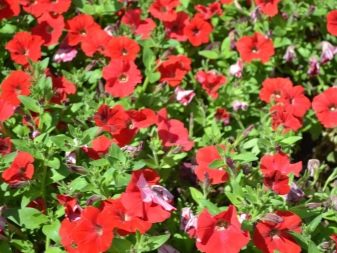
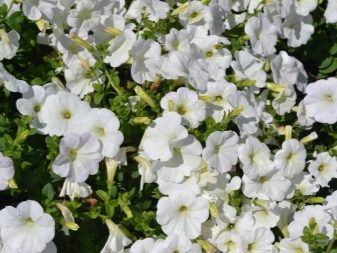
- Opera - has flowers with a red, white and pink tint. Corollas grow small.
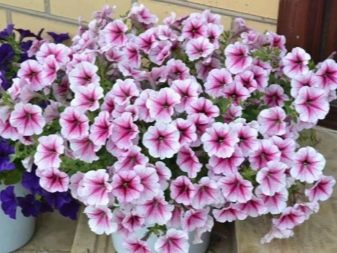
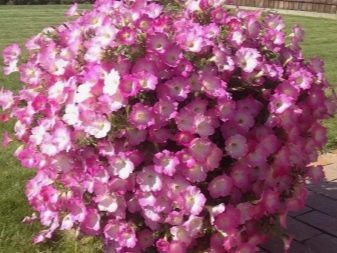
- "Catherine" - refers to hybrid varieties with red-yellow flowers, about 5 cm in diameter.
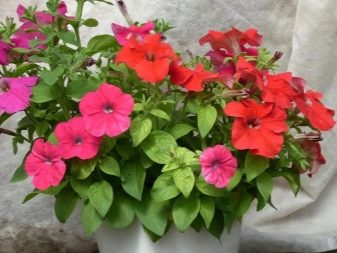
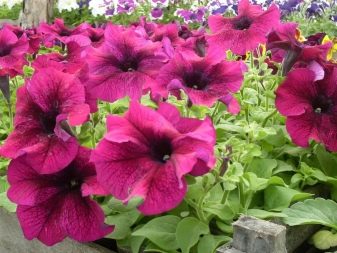
To choose the most suitable version of ampel petunia, you just need to study the color scheme of each variety and know the rules for planting a culture and proper care for it. To make the flower bed look beautiful and interesting, it is important to be able to correctly combine not only the color of the corollas, but also the height of the entire plant, the color and size of its foliage.
Cascade
In the work on the cascading variety, breeders altered the genetic material to make the flower more resistant to weather conditions. Outwardly, the plant resembles a combined bush and ampelous options. Thanks to a stronger stem, the bush grows up, but due to its high weight and flexible shoots, it begins to gradually descend, which creates a cascade. The length of the stems can be different: under normal conditions they reach one and a half meters in length, but with a suitable climate and care, they can grow up to two and a half meters.
Thanks to flexible but strong shoots, petunias can be placed in suspended containers without worrying about their safety, since the presence of winds will not affect their appearance and integrity in any way. In addition, they feel good on the ground, actively growing and displacing all other plants around them.
The cascading variety can be fixed to a mesh or trellis, which will effectively decorate any green area.
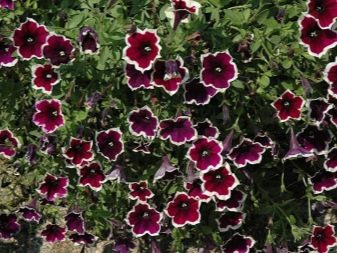

Corollas of this petunia have the same size, varying within 5-6 cm, the number of flowers on one bush is very large, so they often cover the entire bush, hiding its green part under them. The only drawback of this flower is the monochrome shades. Among the most popular varieties, the following are worth noting.
- "La Gioconda" - its advantage can be considered a large palette of colors. The crown is voluminous, rapid growth, is a ground cover.
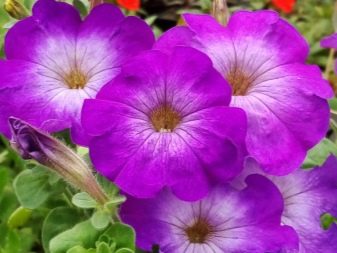
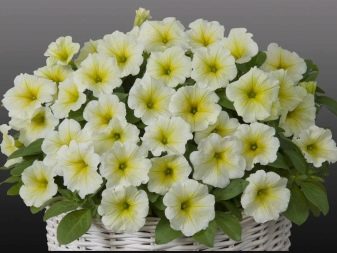
- Super cascade petunia - considered an inexpensive variety, with purple, blue and pink flowers.

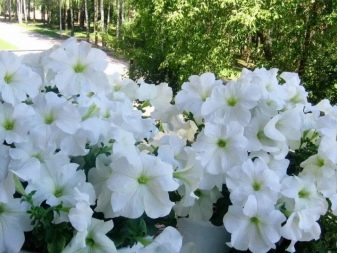
- "Pirouette" - also belongs to inexpensive varieties with large flowers. The color scheme abounds in pinks and reds. Of the advantages, the unpretentiousness of the plant can be noted.

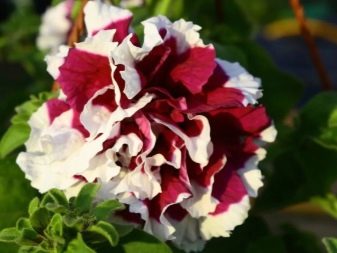
- "Typhoon" - is a series of varieties: "Silver", "Tornado" and "Cherry". Stems usually grow up to one and a half meters, and on soil - up to two meters. Flowers grow up to 5 cm in diameter.

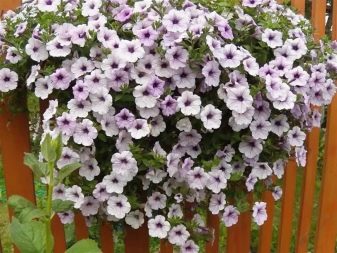
- "Shock Wave" - the variety is a red flower with a rich middle. The plant forms a round head. The advantages include resistance to rain and wind. The shoots are distinguished by good strength, short length, flowers are of modest size.
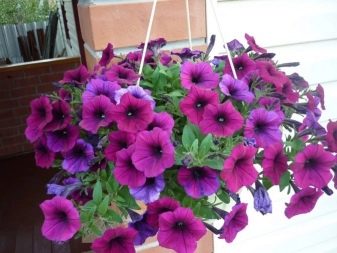
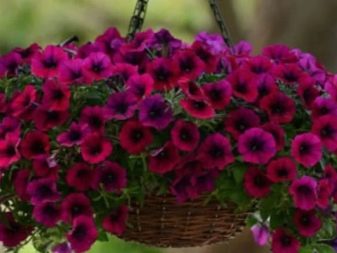
For those looking to decorate a significant area with beautiful flowers that have a long flowering period, cascading petunias are ideal. Due to the long and strong stem, the plant quickly occupies a large area and shades it well, thus maintaining optimal moisture and minimizing the amount of watering.
Major differences
The difference between the ampelous and cascade varieties is well traced only at the initial stage of growth, when it is clearly visible in which direction the stem is growing. If there is a need to determine the variety of plants in the flower garden, then it is better to do this in early spring, while the bushes have not yet grown. To understand how exactly one variety differs from another, you should pay attention to the following characteristics:
- shoot length - ampelous varieties are characterized by a shorter length, rarely reaching a meter in length, while cascading petunias usually grow up to two meters;
- growth pattern - ampelous varieties initially begin to form descending shoots, in contrast to the cascade, which immediately rises up, and then diverges to the sides and falls under its own weight;
- stem thickness - the ampelous variety has thin and fragile stems that easily break from strong gusts of wind, while cascading plants have a strong and thick stem that is not afraid of any winds;
- corolla dimensions - ampelous varieties have rather large flowers, the number of which is not too large, in contrast to the cascading version, which forms whole flower "cushions" of small flowers;
- color - a variety of color options is typical only for ampelous varieties of petunias, cascading plants have one color range;
- the length of the flowering period - the ampelous variety blooms less than the cascading one.
The difference between each of the options makes it possible to choose the right variety for use on the landscape, in a suspended structure or on a support.
See further on the differences between ampelous and cascading petunias.
Growing features
Correct planting and caring for plants makes it possible to get a full and long flowering, as well as the availability of the necessary material for the propagation of the culture next year. If we talk about caring for the ampelous variety of petunia, then it is worth noting that the duration of its flowering increases due to the creation of optimal conditions for the flower.
The most correct capacity will be a hanging planter, which allows the plant to fully grow and bloom, while in standing containers, the middle part gradually begins to thin out, which affects the visual appeal of the bush.


Planting the ampelous variety and subsequent care looks like this.
- The seed sowing procedure should be carried out in the spring. Small-flowered varieties begin the flowering process 10 weeks after planting, and large-flowered varieties - after 12.
- The most suitable soil will be nutritious and loose soil, which is moistened before planting, drainage is laid out on the bottom.
- For proper seed growth, before planting, they should be soaked in a solution of potassium permanganate.
- Sowing of this variety is sparse. The temperature regime should be + 20-25 degrees. After about 10 days, shoots should appear - if this did not happen, then mistakes were made in the sowing procedure.
- When a seedling has more than 3-4 leaves, it must be planted in a pot, where it will grow. For an ampel variety, it is considered normal to place several plants in one pot.
- To quickly adapt to a new place, it is necessary to fertilize a young plant with complex fertilizers applied once a month. To achieve an abundance of flowers, you need to make potassium and magnesium solutions.
- The care process consists in timely watering and loosening of the soil. Petunia loves moisture, so you need to water it daily, and in the hot season you can do this procedure twice a day.
- In order for the plant to bloom luxuriantly and for a long time, it is important to immediately remove all dried buds.
- To plant an ampelous petunia in the open air, it is worth choosing a sunny and quiet place, without drafts.
The process of reproduction of the ampelous variety is better and faster to produce by cuttings in spring or summer, and in a month the new plant will bloom.
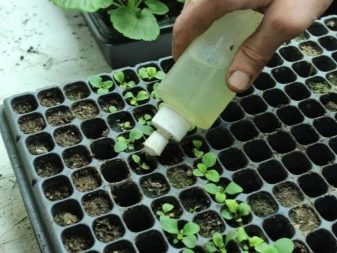

As for sowing a cascade variety and subsequent care, they consist in the following activities:
- sowing seeds should be done in February or March;
- the container for the flower must be prepared: expanded clay is placed on the bottom, then the soil, consisting of a mixture of soil and sand;
- the sowing procedure is sparse, the container is covered with film or glass, aired once a week;
- several young bushes are planted in one pot, which need to be pinched for active growth of the stem;
- the landing site in the ground should be sunny, preferably calm;
- watering is stable, especially in hot weather.
The propagation process is also more efficient and faster with the help of cuttings. Due to the presence of different varieties of petunias, it is possible to decorate the local area or flower garden with the same flower, but different varieties, and get a wonderful composition with different colors and appearance of plants.
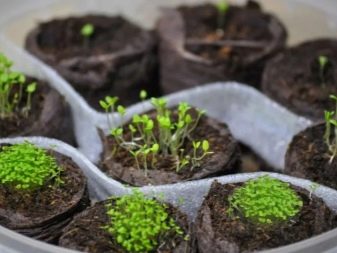








































































































The comment was sent successfully.